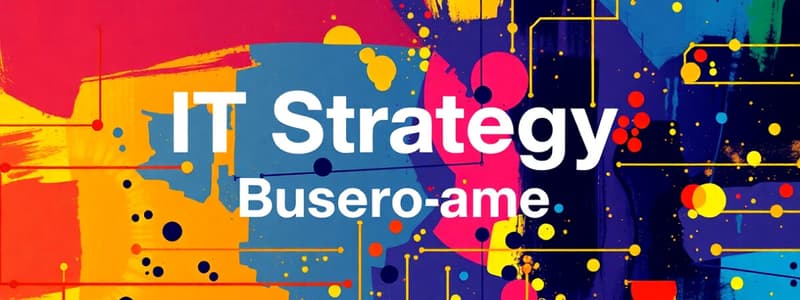Podcast
Questions and Answers
What is the MOST important driver for successful IT strategies?
What is the MOST important driver for successful IT strategies?
- The most cost-effective IT solutions.
- The latest IT capabilities and technologies.
- The opinions of IT specialists.
- Business needs and objectives. (correct)
Which framework is MOST helpful for identifying external strategic opportunities and threats?
Which framework is MOST helpful for identifying external strategic opportunities and threats?
- SWOT analysis. (correct)
- ITIL Framework.
- Cost-benefit analysis.
- ISO 27001.
What is the PRIMARY purpose of IT governance?
What is the PRIMARY purpose of IT governance?
- To encourage innovation at any cost.
- To keep IT costs as low as possible.
- To implement every new IT solution that is made available.
- To ensure accountability, controlling risk, and IT alignment with business goals. (correct)
Which aspect of risk management is CRUCIAL to include within an IT strategy?
Which aspect of risk management is CRUCIAL to include within an IT strategy?
What is the MOST important aspect of IT innovation and change management?
What is the MOST important aspect of IT innovation and change management?
What is CRITICAL for successful implementation of new IT systems?
What is CRITICAL for successful implementation of new IT systems?
Which activity is ESSENTIAL for prioritizing IT projects?
Which activity is ESSENTIAL for prioritizing IT projects?
What does the concept of alignment mean, in the context of IT strategy?
What does the concept of alignment mean, in the context of IT strategy?
Which action is MOST critical for evaluating the return on investment (ROI) of IT?
Which action is MOST critical for evaluating the return on investment (ROI) of IT?
How should IT strategies adapt to shifts in the business environment?
How should IT strategies adapt to shifts in the business environment?
Integrating emerging tech into an existing IT strategy requires which of the following?
Integrating emerging tech into an existing IT strategy requires which of the following?
Why is it crucial to define key performance indicators (KPIs) for an IT strategy?
Why is it crucial to define key performance indicators (KPIs) for an IT strategy?
What is the main role of case studies in the realm of IT strategy?
What is the main role of case studies in the realm of IT strategy?
What makes the process of IT strategy a dynamic one?
What makes the process of IT strategy a dynamic one?
What approach should organizations take to address security risks associated with implementing new technologies?
What approach should organizations take to address security risks associated with implementing new technologies?
What should be tracked and measured when assessing the progress of an IT project?
What should be tracked and measured when assessing the progress of an IT project?
Flashcards
What is IT strategy?
What is IT strategy?
A plan that aligns IT with business goals to achieve them successfully.
What is strategic planning for IT?
What is strategic planning for IT?
Analyzing opportunities and threats using frameworks such as SWOT and PESTEL to identify potential risks and benefits.
What is IT governance?
What is IT governance?
Ensuring accountability, controlling risk, and managing IT resources effectively.
What is IT innovation?
What is IT innovation?
Signup and view all the flashcards
What is IT portfolio management?
What is IT portfolio management?
Signup and view all the flashcards
What is risk management in IT?
What is risk management in IT?
Signup and view all the flashcards
What is change management in IT?
What is change management in IT?
Signup and view all the flashcards
What is cost-benefit analysis in IT?
What is cost-benefit analysis in IT?
Signup and view all the flashcards
Resource Allocation in IT
Resource Allocation in IT
Signup and view all the flashcards
IT Project Evaluation
IT Project Evaluation
Signup and view all the flashcards
IT Investment Tracking
IT Investment Tracking
Signup and view all the flashcards
Adaptable IT Strategies
Adaptable IT Strategies
Signup and view all the flashcards
Integrating Emerging Technologies
Integrating Emerging Technologies
Signup and view all the flashcards
IT Strategy KPIs
IT Strategy KPIs
Signup and view all the flashcards
IT Performance Analysis
IT Performance Analysis
Signup and view all the flashcards
IT Performance Reporting
IT Performance Reporting
Signup and view all the flashcards
Study Notes
Introduction to IT Strategy & Innovation
- IT strategy is crucial for aligning IT with overall business goals.
- Successful IT strategies are driven by business needs, not IT capabilities.
- Strong IT governance is needed for accountability and risk management.
- Innovation in IT must be aligned with business strategy and user needs.
- Strategic planning frameworks (e.g., SWOT, PESTEL) can help identify opportunities and threats.
- Business and IT leaders need strong communication and collaboration.
- Continuous improvement & monitoring of IT strategy is essential.
IT Strategy Formulation
- Understanding business goals is paramount.
- Defining IT's role in achieving business objectives is critical.
- Analyzing business processes and identifying IT improvement opportunities is needed.
- Identifying IT priorities & resource allocation for maximum impact is important.
- Effective solutions require understanding current IT infrastructure and capability.
- Considering various IT technologies & approaches is necessary.
- Choosing suitable IT solutions aligned with budgetary constraints.
- Developing metrics for evaluating the success of the IT strategy is vital.
IT Governance and Risk Management
- Strong governance is essential for ensuring accountability and controlling risk.
- IT strategy should incorporate risk assessment and mitigation plans.
- Risk management frameworks (e.g., ISO 27001) can improve security.
- Establishing clear roles & responsibilities within IT governance policies are important.
- Maintaining compliance with relevant regulations and standards is necessary.
- Information security policies & procedures must be implemented and updated regularly.
- Monitoring & audit of IT systems are essential for compliance and to ensure integrity.
IT Innovation and Change Management
- Identifying and fostering innovation within IT is essential.
- IT should drive innovation to improve efficiency and effectiveness.
- Understanding market trends & customer needs is important for strategic innovation.
- Effective change management is crucial for successful implementation of new IT systems.
- Communicating the benefits of IT innovation effectively is critical for stakeholder buy-in.
- Training and support for staff to use new IT solutions are needed.
IT Portfolio Management
- Managing the IT portfolio is crucial for prioritizing projects and investments.
- Applying principles of cost-benefit analysis in investing in IT projects.
- Allocating resources effectively across various IT initiatives.
- Evaluating and managing existing IT projects & solutions is needed.
- Tracking & monitoring IT investments is essential for evaluating ROI.
IT Strategy in Different Business Environments
- IT strategies need to adapt to various business environments (e.g., emerging technologies, globalization, economic downturns).
- Understanding industry trends and competitors' strategies is important for planning.
- Adapting IT strategies to the ever-changing competitive landscape is essential.
- IT strategy should support expansion into new markets/products/services.
Emerging Technologies and IT Strategy
- Technologies like cloud computing, big data, and AI are transforming IT.
- Integrating these new technologies into existing IT strategies and processes is increasingly important.
- Understanding the potential of IoT and its integration opportunities is necessary.
- Security concerns associated with new technologies need careful consideration.
- Determining and implementing new skill requirements for IT staff will be important.
Measuring & Evaluating IT Strategy Performance
- Defining key performance indicators (KPIs) for IT strategy evaluation is essential.
- Measuring & analyzing IT performance metrics (e.g., efficiency, effectiveness, ROI) is crucial.
- Identifying areas for improvement based on performance analysis is vital.
- Reporting and communicating performance data to stakeholders is absolutely necessary.
Case Studies and Real-World Applications
- Case studies illustrate the application of IT strategy concepts.
- Real-world examples demonstrate how IT strategies have influenced business success.
- Practical applications provide insights into implementing strategies.
Conclusion
- IT strategy development needs careful planning, execution, and continuous improvement to align with business needs.
- A strong IT strategy is critical in the digital age.
- The process of IT strategy is a dynamic and evolving one.
Studying That Suits You
Use AI to generate personalized quizzes and flashcards to suit your learning preferences.




